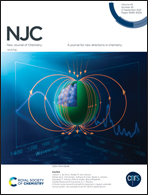Slight structural modulation around a pivotal bond: high impact on enantiomeric stability†
Abstract
Based on a N-arylthiazoline scaffold, 22 structures with a N–Caryl chiral axis were synthesized exhibiting a huge molecular diversity for the four flanking substituents around the pivotal bond. The determination of their corresponding rotational barriers by thermal kinetic experiments or from the analysis of plateau shape chiral HPLC chromatogram allowed to rank these compounds according to their enantiomeric stability: 4 rotamers, 5 isolable atropisomers (i.e. not enough robust to be handled without risk of racemization) and 13 stable atropisomers. The influence of the flanking substituents was investigated showing that a minor structural modification may result in a drastic change on the value of the rotational barrier. All these results offer a set data on structure-rotational barrier relationships very helpful to design molecules exhibiting chiral axis or to optimize the enantiomeric stability of such structure. To complete this study, the racemization pathways were examined thanks to X-ray analysis and DFT calculations, highlighting the importance of the aromatic ring distortion during the transition state on the energetic cost of the rotation.



 Please wait while we load your content...
Please wait while we load your content...